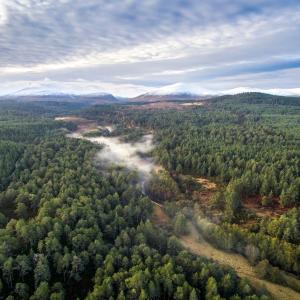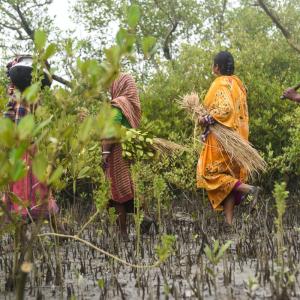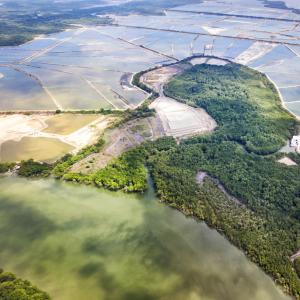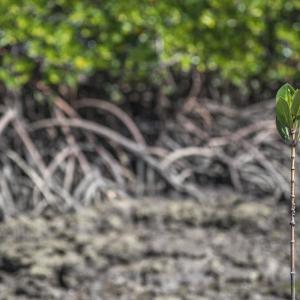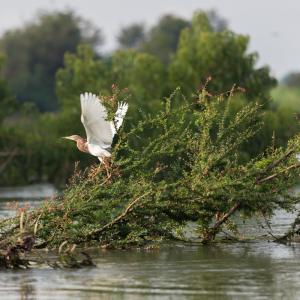Nature-based Solutions (NbS) play an important role in mitigating climate change and restoring nature. Support to scale NbS, together with urgent action to decarbonise our global economy, will be key to a successful COP28.
To stop the world from warming by more than 1.5°C, UNEP estimates that we need to invest US$11 trillion in NbS between now and 2050. Currently US$133 billion are invested annually and only 14% is financed by the private sector.
We urgently need to unlock investment and remove barriers to scaling up NbS. One of these barriers is ensuring NbS projects are investment ready. This means they can approach different types of investors demonstrating the opportunity for a financial return, and can show how they will achieve positive impact for people, nature and climate.
In November 2023, we announced the selection of six projects from around the world that will receive support from our Nature-based Solutions Accelerator (NbS Accelerator) with the aim to help them reach investment readiness. These projects are grounded in a commitment to deliver positive impacts on people, nature and climate, and each showcases a different type of NbS and investment model.
From our call for proposals and during the selection process, we noticed some key trends and lessons surfacing, offering valuable insights for those interested in supporting NbS projects and scaling NbS investments.
1. Use of established definitions for NbS is important
The NbS concept is often confused with related terms such as Natural Climate Solutions and Bankable Nature Solutions.
Many proposals submitted to the NbS Accelerator showed a weak connection to biodiversity impact, which is core to the definition of NbS. Clear and robust use of well-established definitions is key to instilling confidence in investors and other stakeholders, for example by aligning projects with best practices such as the IUCN Global Standard for NbS and the WWF Guide for Practitioners.
NbS and related definitions
-
Detailed NbS criteria
(Adapted from WWF’s ‘How to Design High-Quality NbS Field Projects: A Guide for Practitioners’)
WWF suggests following the IUCN Global Standard in the design of NbS. The proposed Nature-based Solution must explicitly incorporate all the following components:
- Be a place-based intervention that uses the functioning power of ecosystems.
- Address one or more of the societal challenges as categorised within the IUCN Global Standard for NbS.
- Use nature sustainably; and improve biodiversity.
- Consider the co-benefits and trade-offs of the nature-based solutions for people and biodiversity.
- Contribute directly and tangibly to human wellbeing at the local level.
- Be designed and implemented with engagement, participation, and consent of all the stakeholders.
Additionally, the following elements are important principles underlying the concept of NbS:
- Have a landscape/seascape intention and cross-sectoral and thematic approach.
- Address current and future climate risks and impacts to both the ecosystems and people in the project area.
- Be context-specific and appropriate.
- Be cost-effective in relation to other solutions (such as hard infrastructure or technological ones).
- Have a long-term perspective, even if the funding is short-term.
2. NbS project implementers and developers are hugely diverse
Proposals to the NbS Accelerator represented a wide range of geographies, ecosystems, business models, organisation types and NbS activities. While only a small sample size, this challenges the traditional dominance of NGO-led and forest-focused projects. There were good examples of partnerships between larger entities and smaller regional NGOs, however, more representation from Indigenous People’s Organisations and community-led organisations is needed for long-term ownership and socially-just outcomes. Investors and other funders should be open to, and seek out, a range of NbS types, and stipulate the importance of community-led initiatives in their funding criteria.
3. NbS project teams need to build confidence in commercial project design, and clear criteria for investment readiness can help
Out of the submissions received, we found only a small pool of projects with the capabilities needed to design a commercial project that could attract private - or blended - finance. Many struggled to articulate a commercial vision, including revenue generation and financial forecasting, and were more accustomed to grant funding. Commercial expertise and mentoring are imperative to bridge this gap, with early-stage funding requiring flexibility to allow projects to prove their commercial viability. Clear criteria for investment readiness helped projects understand the expectations of the accelerator, and to de-mystify the concept of investment readiness.
It was clear that projects need to also better understand the types of impact metrics that investors are looking for, so they can clearly articulate their value for investors. For example, requirements from the Taskforce for Nature Related Financial Disclosures (TNFD) will soon be top-of-mind for many investors and WWF is working on a guidance tool on this for NbS projects to be published in early 2024.
Components of Investment readiness for NbS
Commercial potential:
- Clear marketable products/services and route to market, identifiable buyers
- Demonstrated awareness of business risks (from an investor perspective)
Commercial implementation:
- How revenues are generated (supply chain, intermediaries, contractual mechanisms)
- Structure of business and resourcing (legal form, partners, contractors, staffing)
- Economic benefit, including local income generation and benefit sharing
Revenue and forecasts:
- Financial forecast with revenue and costs, showing investment repayment period OR outlining how and when this forecast can be made
4. Policy change is a critical factor to unlock revenue options for NbS projects
Currently, NbS project revenue comes mainly from agricultural product sales and other raw material commodities, such as rubber, or from voluntary carbon markets. Investors prefer to see a range of revenue sources (known as ‘stacking’) to reduce investment risk and generate larger returns, so diversifying revenue streams beyond agriculture and carbon could increase access to private finance. To enable this, policy-based mechanisms are needed, which can incentivise high-quality NbS and create standardised markets that give investors confidence. These include payment for ecosystem service (PES) and insurance-based schemes for disaster risk reduction. In the UK, one of the accelerator projects is engaging with an emerging policy on ‘Biodiversity Net Gain’, which should provide a new revenue stream.
5. Supporting place-based projects that are designed for replication can catalyse the NbS market
NbS are most effective when implemented within a holistic landscape approach. However, to build up to landscape scale, place-based projects that are responsive to locally-defined challenges and opportunities are essential. Quality NbS at the project scale can help by demonstrating impact and learning, which can then be replicated within the landscape or other regions. Alongside the NbS accelerator, investors and other actors can help catalyse this market growth by supporting project-scale NbS with technical support, grants and concessional finance.
Through the NbS Accelerator we will continue to learn and develop insights into the barriers and opportunities for NbS. By sharing these lessons, we hope to spark conversations and drive actions that ensure the implementation of NbS with integrity and enable access to private finance sources to reach their scaling potential.

